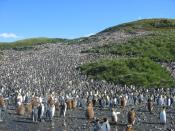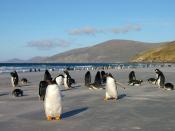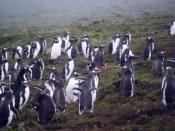The Emperor penguin is the biggest of all the penguins. They are found in the Weddell Sea and Dronning Maud Land, Enderby, Princess Elizabeth Lands, and the Ross Sea, Emperors bree on the sea ice in very cold conditions. They donÃÂt use nests or protect an area for their young, but use their warm bodies instead to raise and warm their chicks. This breeding technique have developed to allow chicks to grow to independence at a time when food is common and their killers not many.
They have a huge head, short, thick neck, a short tail, and tiny wings. Emperor Penguins have blue-grey upper body and blackish-blue heads mixed with large white and yellow ear small areas. Their lower body are mainly white with the breast showing yellow. Like all penguins, Emperors have waterproof feathers that help keep their skin dry and wide feet which they use for swimming.
But unlike many penguins, which eats surface krill, Emperor penguinsÃÂ diet are fish, squid, and crustaceans that they catch when swimming underwater. They will reach more than 700 feet depth and can be underwater for more than 18 minutes.
King penguins are found in large populations on the Falkland Islands, Macquarie Islands, Heard Island, Iles Crozet and Marion island. They have been hunted in the past, but continued to increase until their conservation status now seems secure. The features of the King penguin is a silvery-grey back with a blackish-brown head mixed with ear patches of golden-orange. They close looking with the Emperor Penguin but can be identified by the orange on their breasts, more straighter bodies and longer beaks.
Kings catches its food by underwater pursuit, using their flippers to reach many hundred feet. Dives can last 15 minutes or more until needing for air. Their diet are...


